
With new subscribers coming on board, we are seeing emails similar to the one below. We are working on improving our onboarding process, but in the meantime the answer to the email excerpt below should clear a few things up.
I am a new subscriber...I have been somewhat confused about how to use the many indicators that you publish to support specific buy and sell decisions. Please help.
The DP Alert Report is set up the same way every market day so that we look at the same charts and understand their nuances as they change. That can sometimes be confusing as our discussion of each indicator chart may contradict. This is why the "CONCLUSION" is the most important section of this report.
In the Conclusion we assimilate all of the indicator data and give you our current thoughts on whether we are bullish/bearish. We take great care everyday to make the Conclusion as tight and insightful as possible.
The other important section to review is "Bias Assessment". This section reveals what participation is telling us about the bias of the market. It may not change daily, but it is an essential tool for trading. Risks are greater in a market with a bearish bias.
Think of it this way, the first part of the DP Alert sets the backdrop as we go through price and indicator charts. The bias then wraps up risk and the conclusion tells you our final thoughts after reviewing all of the indicators.
If you ever have a question or concern about your subscription, email support@decisionpoint.com.
The DecisionPoint Alert Weekly Wrap presents an end-of-week assessment of the trend and condition of the Stock Market, the U.S. Dollar, Gold, Crude Oil, and Bonds. The DecisionPoint Alert daily report (Monday through Thursday) is abbreviated and gives updates on the Weekly Wrap assessments.
Watch the latest episode of DecisionPoint on StockCharts TV's YouTube channel here!
MAJOR MARKET INDEXES
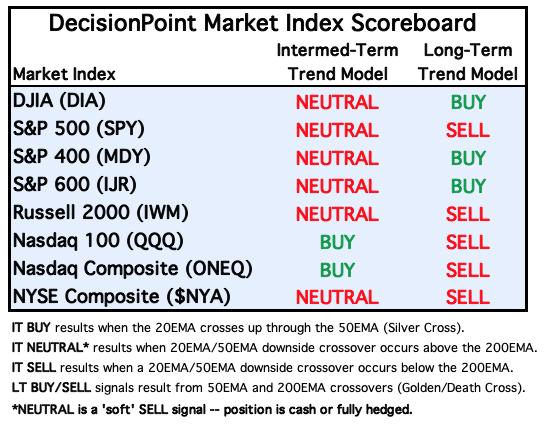
For Today: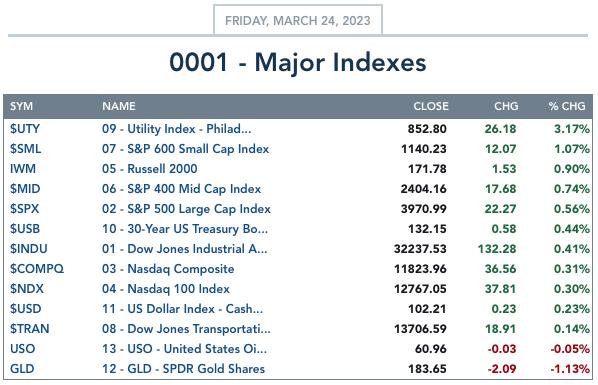
For the Week: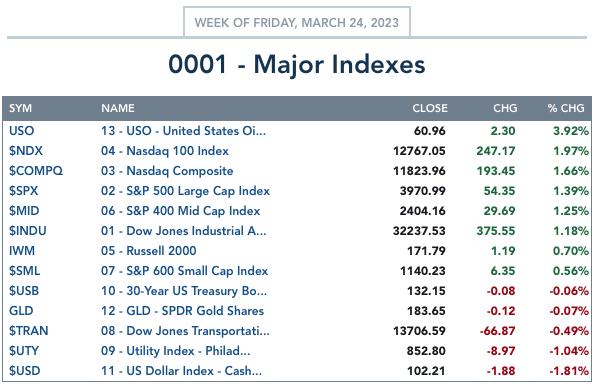
SECTORS
Each S&P 500 Index component stock is assigned to one of 11 major sectors. This is a snapshot of the Intermediate-Term (Silver Cross) and Long-Term (Golden Cross) Trend Model signal status for those sectors.
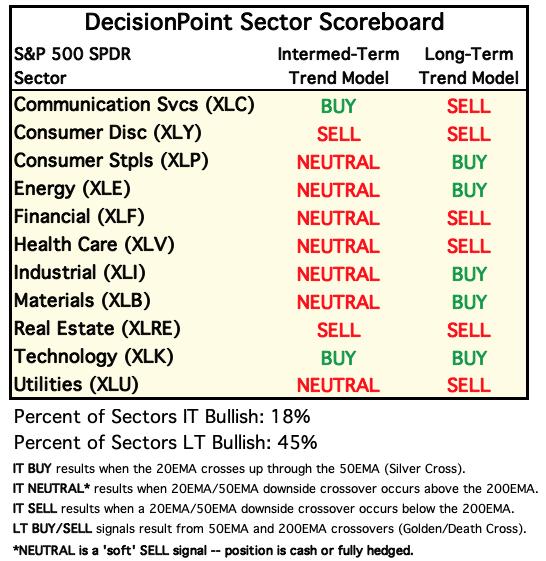
For Today: 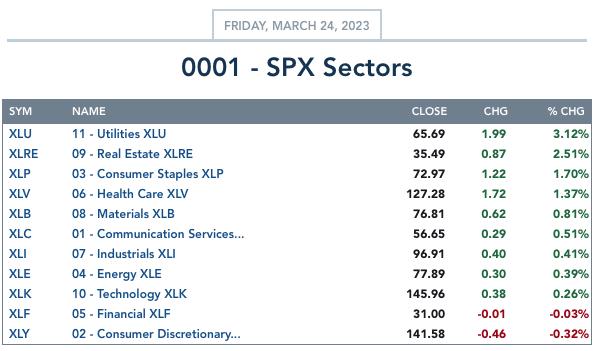
For the Week:
CLICK HERE for Carl's annotated Sector charts.
THE MARKET (S&P 500)
IT Trend Model: NEUTRAL as of 3/13/2023
LT Trend Model: SELL as of 3/23/2023
SPY Daily Chart: The short-term rising trend was definitely breached to finish the week, but price managed to close within the rising trend. Friday saw a bullish engulfing candlestick. These one-day patterns suggest the next day will see a rally of some sort.
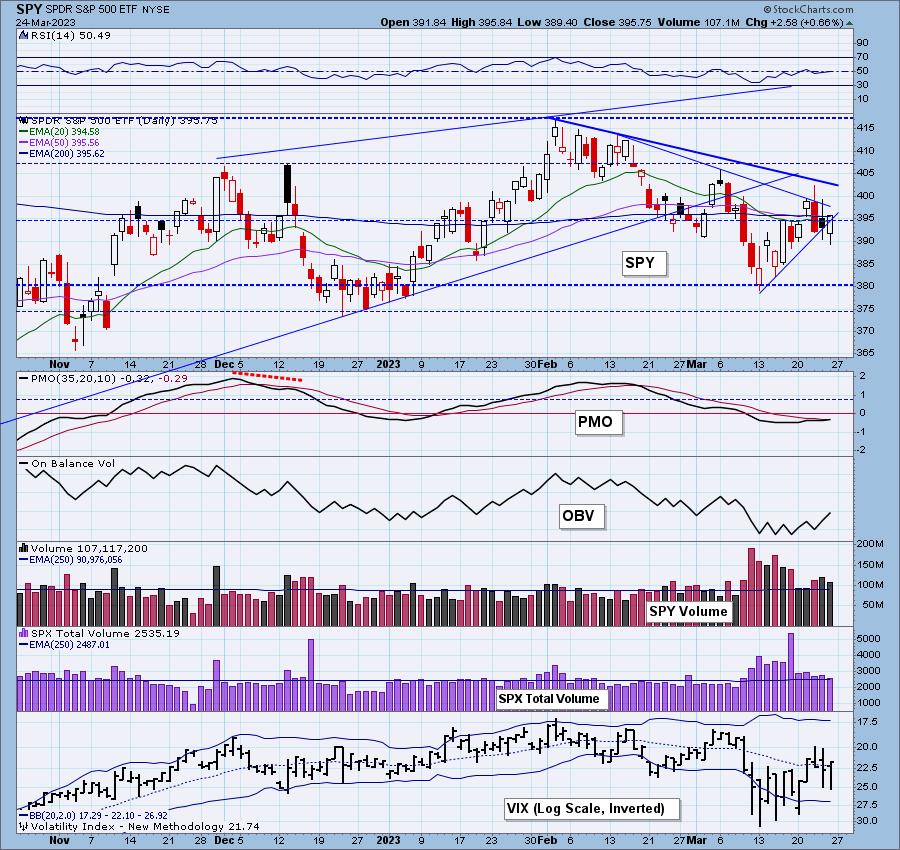
The primary indicators are mostly neutral which isn't enlightening. The RSI is sitting on net neutral (50) and Stochastics while in positive territory have topped. The PMO is nearing a crossover BUY signal, but it is traveling sideways. Even the VIX is sitting on its moving average.
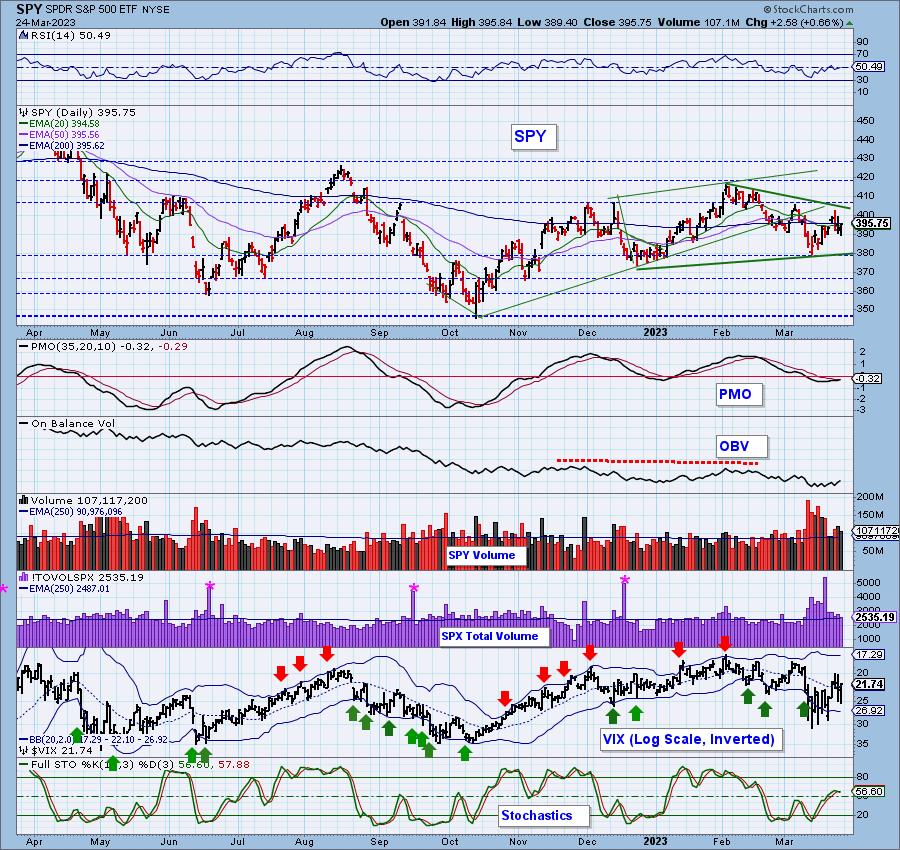
SPY Weekly Chart: The longer-term rising trend was compromised two weeks ago and the rally of last week and this week haven't helped it recapture that trend. On the good news side, the weekly PMO has bottomed above its signal line which is very bullish for the PMO.
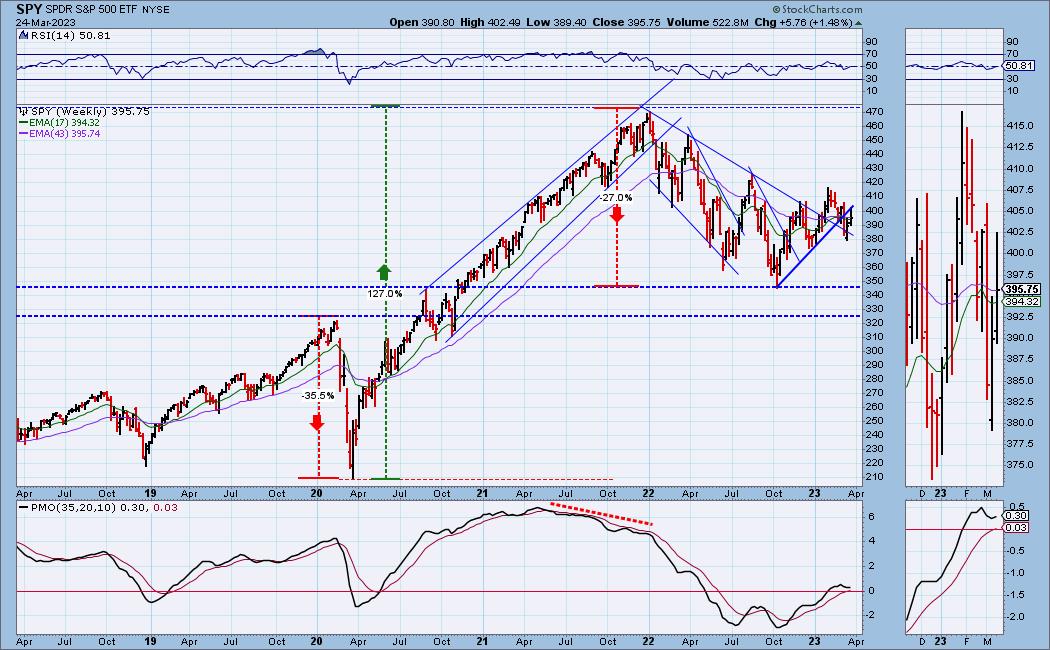
New 52-Week Highs/Lows: New Lows expanded quite a bit on Friday's rally and New Highs contracted. That is a one-day negative divergence that we don't like. The 10-DMA of the High-Low Differential is beginning to angle back up, but ultimately it is confirming the declining trend.
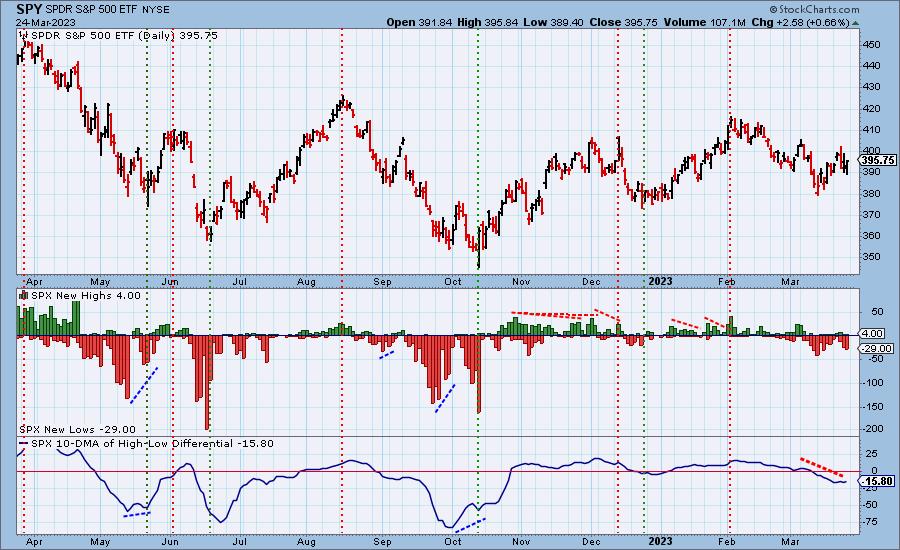
Climax Analysis: There were no climax readings today. However, we did see three climaxes this week. Monday was an upside initiation climax which did result in higher prices the next day. That day saw an upside exhaustion climax which fulfilled on the big decline Wednesday. That was a downside initiation climax and while we've had two days of rally, the declining trend began after that climax.
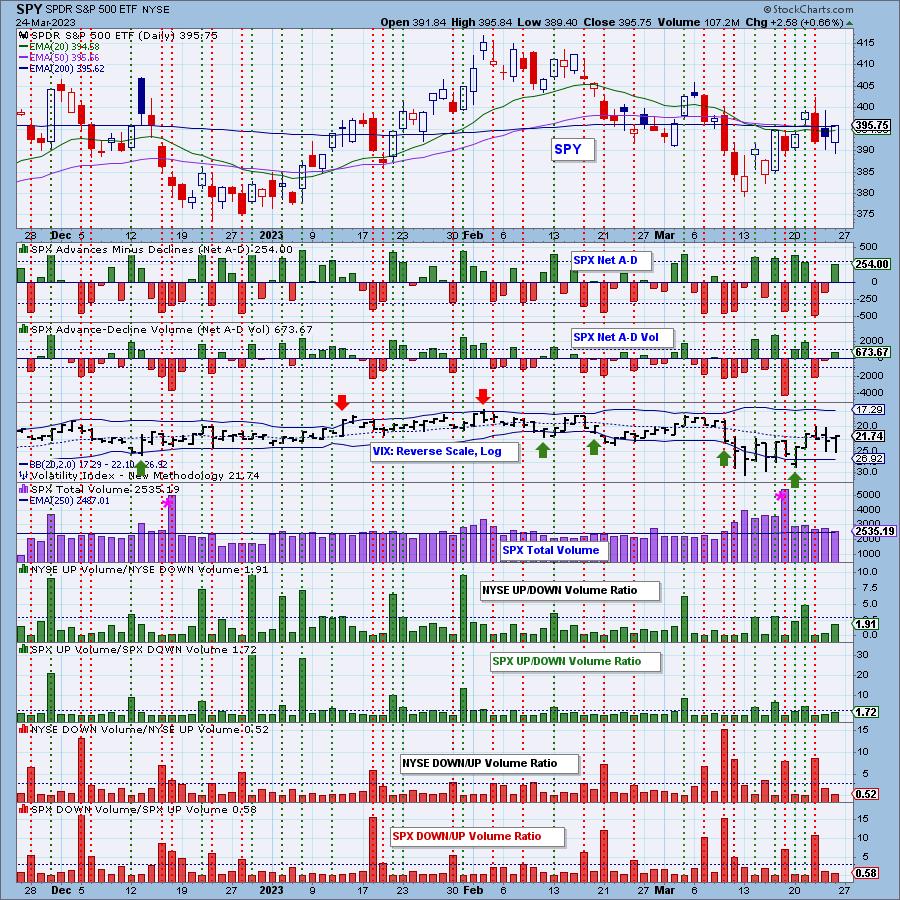
*A climax is a one-day event when market action generates very high readings in, primarily, breadth and volume indicators. We also include the VIX, watching for it to penetrate outside the Bollinger Band envelope. The vertical dotted lines mark climax days -- red for downside climaxes, and green for upside. Climaxes are at their core exhaustion events; however, at price pivots they may be initiating a change of trend.
Short-Term Market Indicators: The short-term market trend is UP and the condition is NEUTRAL.
While New Highs didn't expand and New Lows expanded, the Swenlin Trading Oscillators turned back up. Participation is improving with nearly half of the stocks having rising momentum and more stocks moving above their 20-day EMAs. This chart is encouraging.
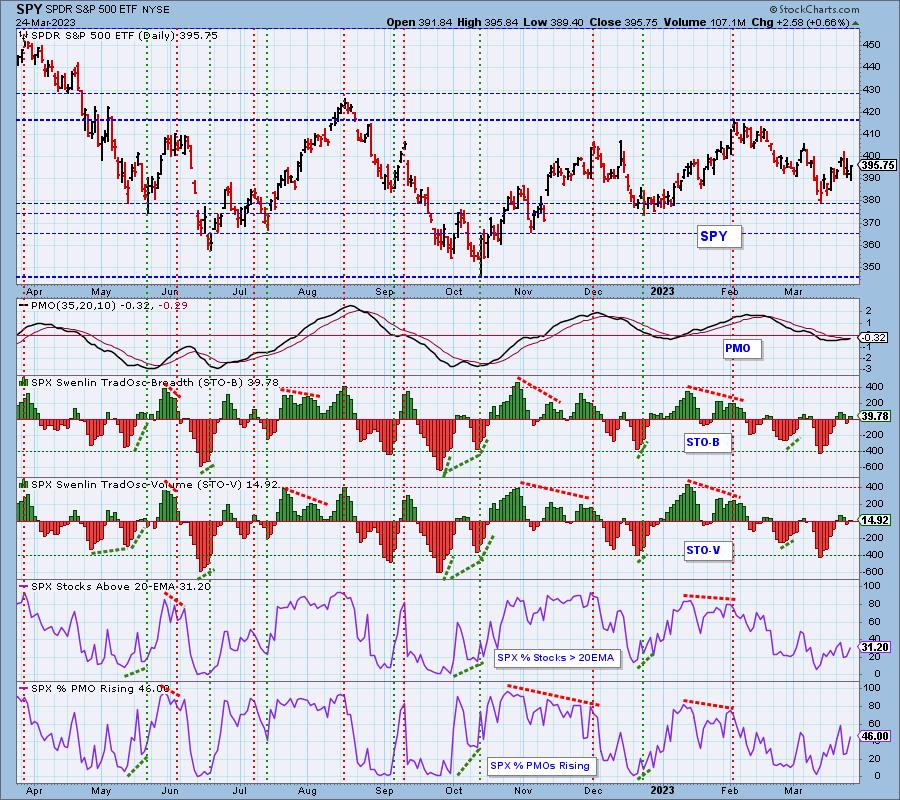
Intermediate-Term Market Indicators: The intermediate-term market trend is DOWN and the condition is OVERSOLD.
More encouraging news from our IT indicators. Both the ITBM and ITVM turned up to confirm the newly rising short-term indicators. We also saw a reversal on %PMO BUY Signals. Given we have 45% of stocks with rising PMOs, we should see this indicator continue higher.

_______
PARTICIPATION and BIAS Assessment: The following table objectively shows the depth and trend of participation in two time frames.
- Intermediate-Term - the Silver Cross Index (SCI) shows the percentage of SPX stocks on IT Trend Model BUY signals (20-EMA > 50-EMA). The opposite of the Silver Cross is a "Dark Cross" -- those stocks are, at the very least, in a correction.
- Long-Term - the Golden Cross Index (GCI) shows the percentage of SPX stocks on LT Trend Model BUY signals (50-EMA > 200-EMA). The opposite of a Golden Cross is the "Death Cross" -- those stocks are in a bear market.
The following table summarizes participation for the major market indexes and sectors. The 1-Week Change columns inject a dynamic aspect to the presentation. There are three groups: Major Market Indexes, Miscellaneous Sectors, and the eleven S&P 500 Sectors.
NEW SECTORS ADDED! We have begun collecting SCI and GCI data for four new sectors: Biotechnology (IBB), Regional Banking (KRE), Retail (XRT), and Semiconductor (SMH).
The highest IT Bias goes to Gold Miners (GDX) at +6. A negative IT Bias tells us that the shorter-term (SCI) holds a lower percentage that the long-term (GCI). A negative bias typically tells us that the short-term is likely breaking down or has broken down.
The lowest IT Bias goes to Transports (IYT). It isn't surprising given the decimation of the SCI and already faltering GCI.
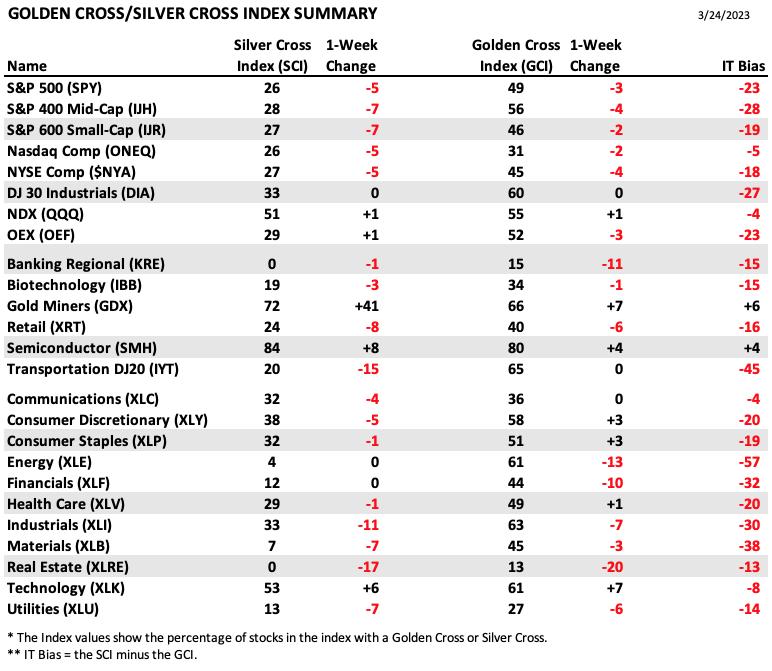
This table is sorted by SCI values. This gives a clear picture of strongest to weakest index/sector in terms of intermediate-term participation.
The highest SCI value belongs to Semiconductors (SMH). This isn't a surprise given they have led nearly every rally we've seen. Not only is it the highest, but it improved both its SCI and GCI this week.
The lowest SCI percentage is a tie between Regional Banks (KRE) and Real Estate (XLRE). Banks are not a surprise. Seeing the breakdown in the SCI and GCI by 17 and 20 percentage points respectively tells us this sector is very weak under the surface.
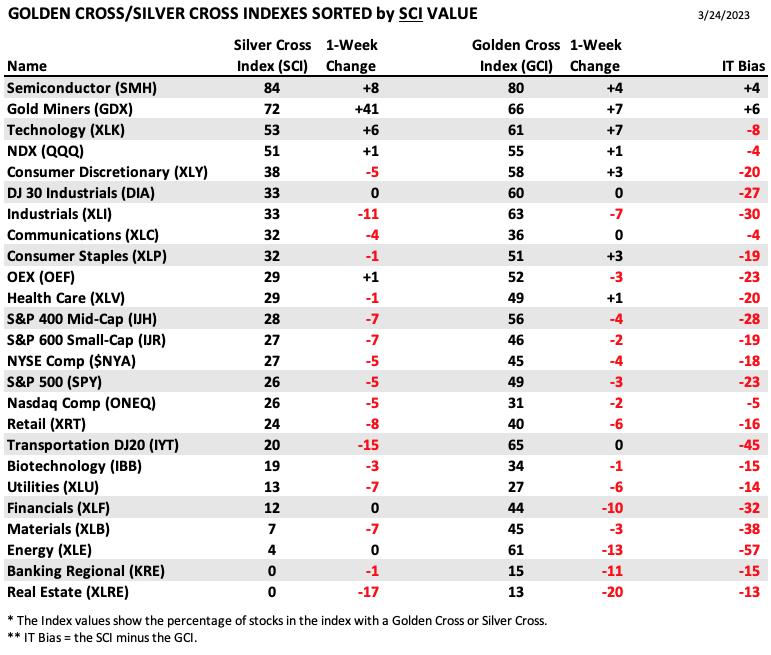
This table is sorted by GCI values. This gives a clear picture of strongest to weakest index/sector in terms of long-term participation.
The highest GCI value belongs to Semiconductors (SMH) which we've already noted is the healthiest industry group we cover. However, we cannot ignore the 41 point increase on Gold Miners (GDX). This group is showing incredible relative and internal strength.
The lowest GCI value falls to Real Estate (XLRE) which is breaking down even more than Banks (KRE). This sector has lots of work to do, but given the continued loss to SCI and GCI values, we don't think that will be happening too soon.
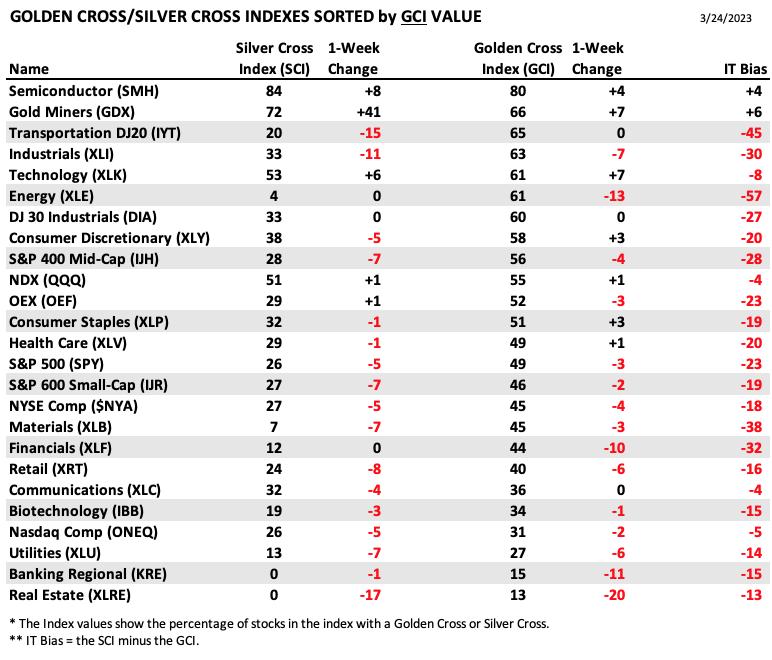
The following chart objectively shows the depth and trend of participation in three time frames.
The market bias is BEARISH.
The short-term bias is BULLISH.
The intermediate-term bias is BEARISH.
The long-term bias is BEARISH.
The short-term bias is improving given we have expanding participation of stocks above their 20/50-day EMAs. Those participation percentages are greater than the SCI percentage as well. The SCI is still in decline with a puny 26.4% reading, keeping the IT bearish. The GCI is higher than the participation of stocks above their 50/200-day EMAs. This means the GCI will not likely turn back up as we need price to be above both the 50/200-day EMAs in order to have a "golden cross" on a stock.
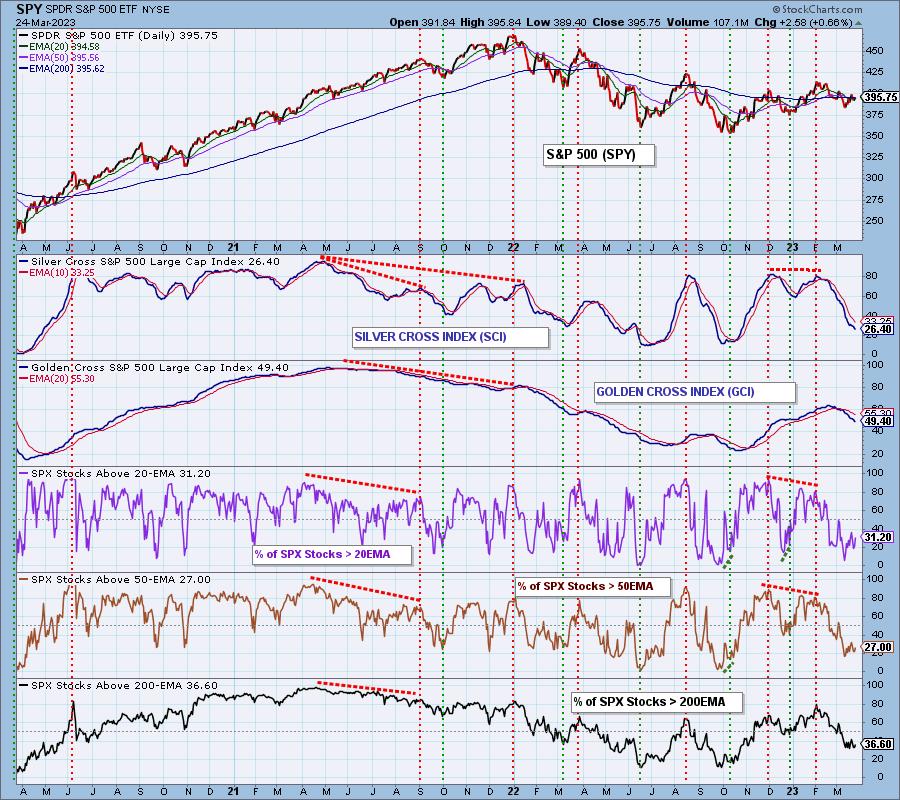
CONCLUSION: Clearly the short-term is beginning to see improvements. We have both the STOs rising and the ITBM/ITVM are confirming those bullish changes by rising themselves. The short-term bias has moved bullish for now. The PMO is nearing a crossover BUY signal. A rally next week is likely based on those indicators. The overall economic environment tells us the market is extremely vulnerable to whipsaw. Whipsaw in this market has been brutal so we need to remain cautious about expanding our portfolios. Inverse positions can likely be left on the table, but stops should be set in case a rally gets legs.
Erin is 15% long, 2% short.
Have you subscribed the DecisionPoint Diamonds yet? DP does the work for you by providing handpicked stocks/ETFs from exclusive DP scans! Add it with a discount! Contact support@decisionpoint.com for more information!
BITCOIN
Bitcoin has been digesting the strong rally from earlier this month. The top is beginning to round, however so caution is warranted. While the RSI is positive, the PMO is decelerating and Stochastics have topped. We even have a slight negative divergence with the OBV. Bitcoin looks ready to pullback toward the February high.
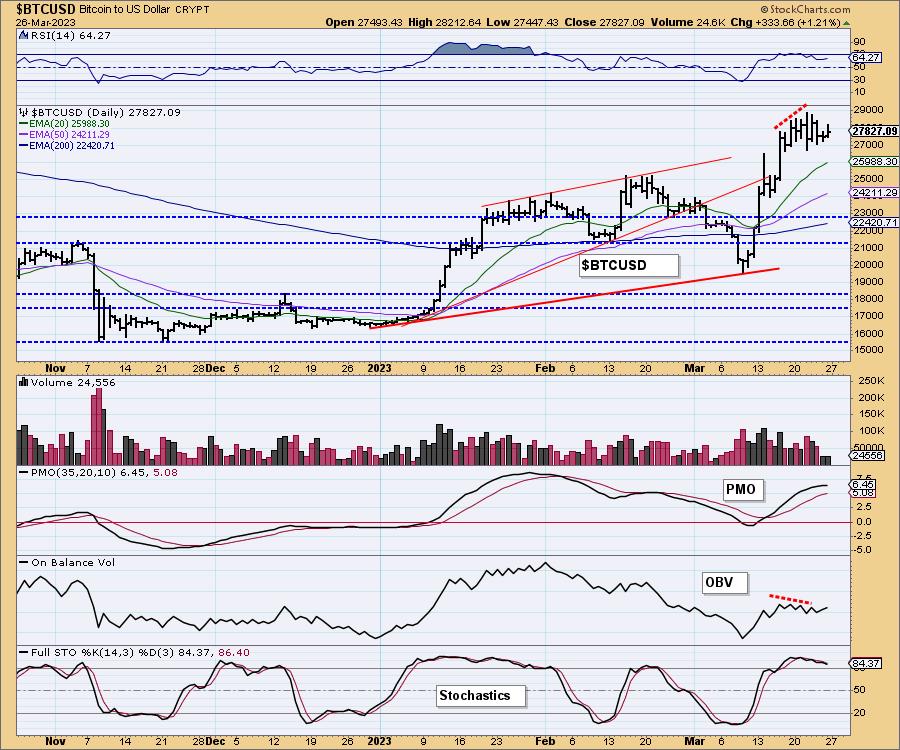
This chart is to show where some of the support/resistance lines come from. It isn't surprising to see Bitcoin faltering here given long-term overhead resistance.
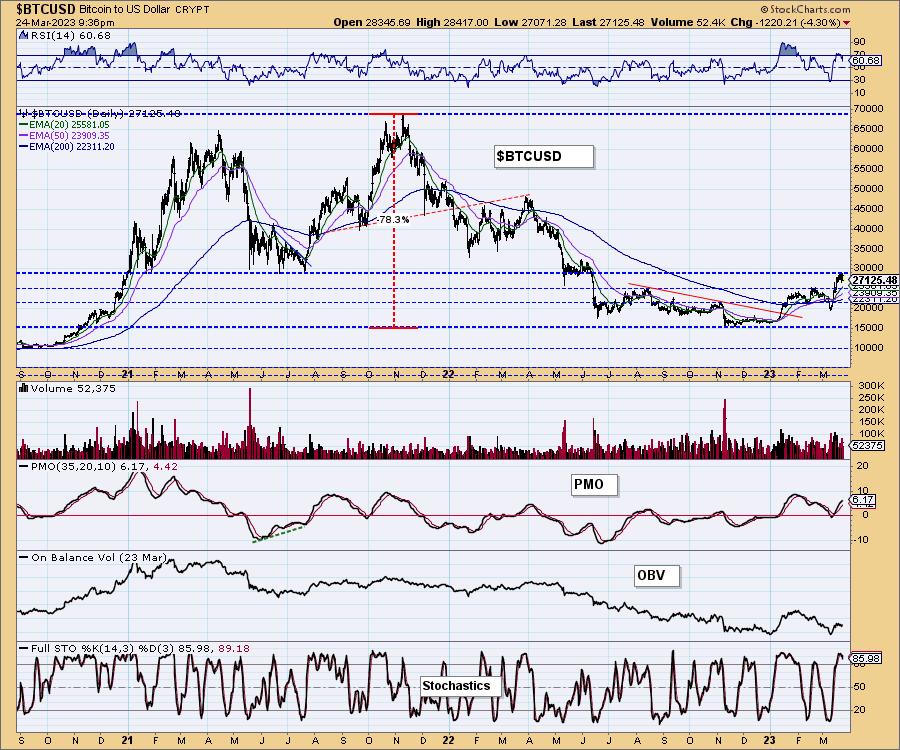
INTEREST RATES
Interest rates dove this week with many yields breaking strong support at December and February lows.
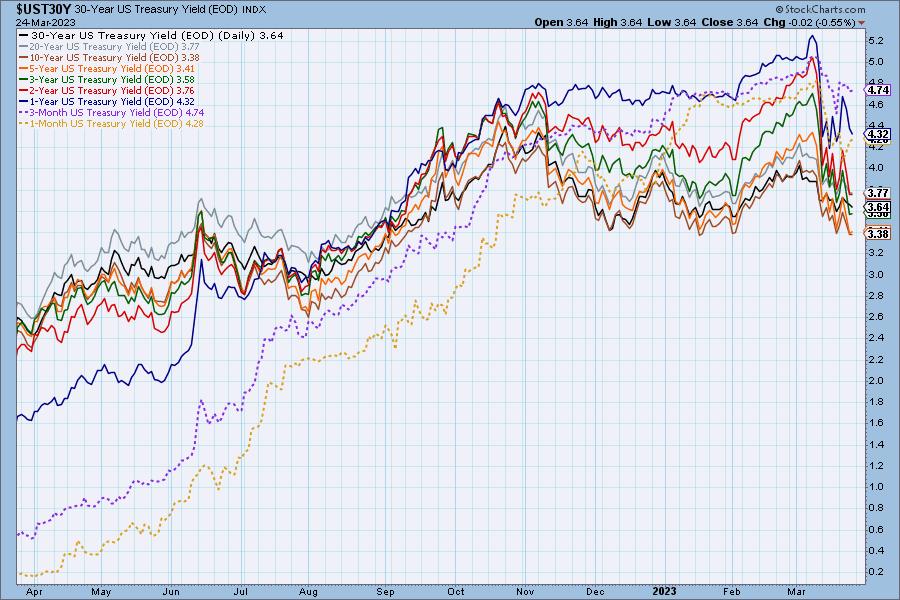
The Yield Curve Chart from StockCharts.com shows us the inversions taking place. The red line should move higher from left to right. Inversions are occurring where it moves downward.
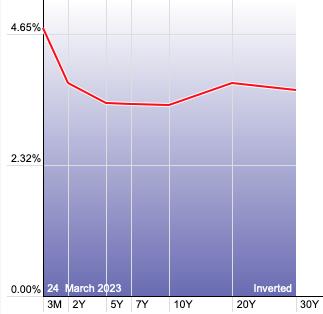
10-YEAR T-BOND YIELD
$TNX dropped below strong support but did manage to get back above before the close. Still, this is a major breach of strong support and the 200-day EMA. The RSI is negative and the PMO is in decline in negative territory. Stochastics are in the basement and still declining. We expect a breakdown in the 10-year yield that follows the breakdowns of short-term term yields.

MORTGAGE INTEREST RATES (30-Yr)**
**We watch the 30-Year Fixed Mortgage Interest Rate, because, for the most part, people buy homes based upon the maximum monthly payment they can afford. As rates rise, a fixed monthly payment will carry a smaller mortgage amount. As buying power has been shrinking, home prices have come under pressure.
--
This week the 30-Year Fixed Rate fell from 6.60 to 6.42.
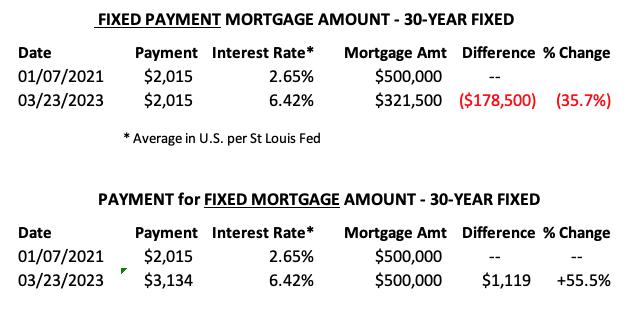
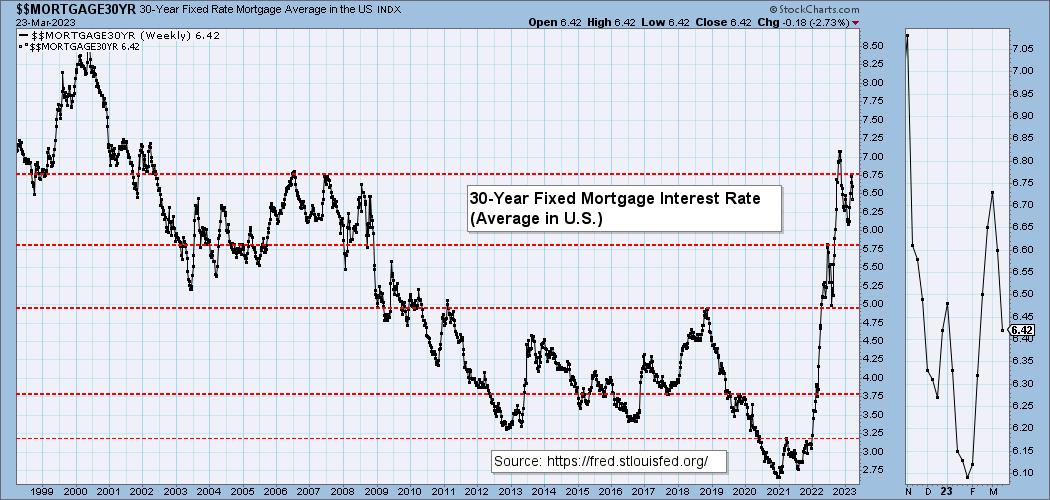
DOLLAR (UUP)
IT Trend Model: BUY as of 2/27/2023
LT Trend Model: SELL as of 1/31/2023
UUP Daily Chart: UUP nearly saw a "Dark Cross" of the 20/50-day EMAs. It will likely materialize this week. Price will need to get above both in order to avoid that IT Trend Model Neutral Signal. Given the indicators, that is plausible. Stochastics have turned back up and the RSI, while negative, is rising. The PMO is flattening already so we see at best a break above those moving averages with worst case likely being consolidation between December lows and the January high.

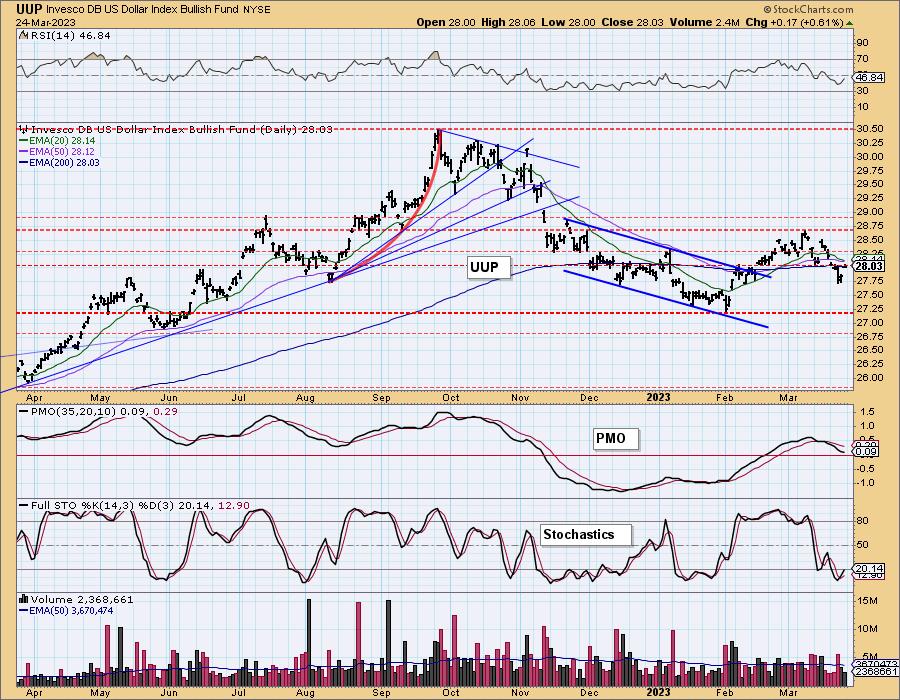
UUP Weekly Chart: This is a good place to see a bounce as price is laying atop strong support. However, weekly indicators don't support this conclusion. The RSI just moved into negative territory and the weekly PMO has bearishly topped beneath its signal line. Short term, the Dollar has promise, but we must remember that the longer-term bias is bearish.
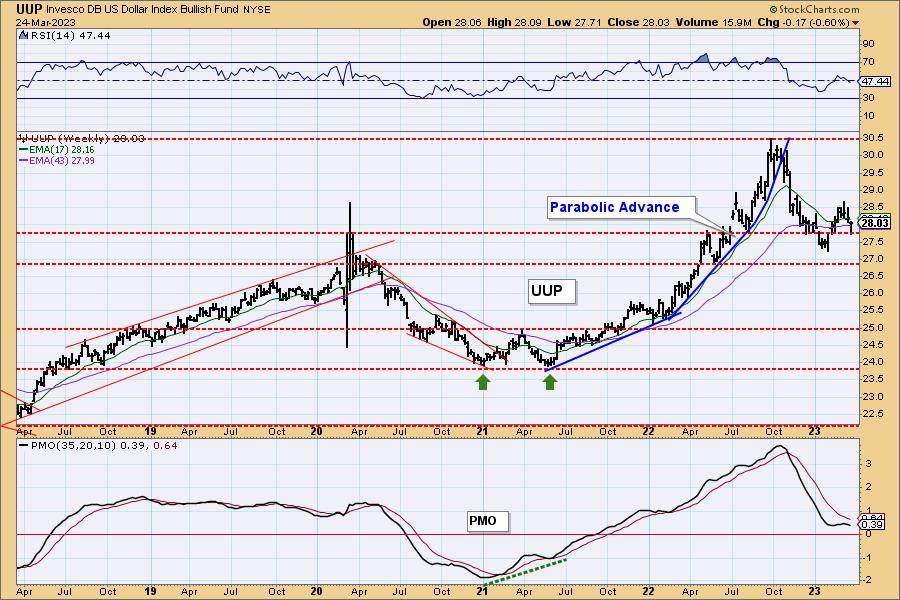
GOLD
IT Trend Model: BUY as of 3/7/2023
LT Trend Model: BUY as of 1/5/2023
GOLD Daily Chart: Gold has been quite the darling with many investors opting to go with the metal given the banking crisis. We believe this will continue, but this rising trend is still quite steep and new all-time highs are approaching.
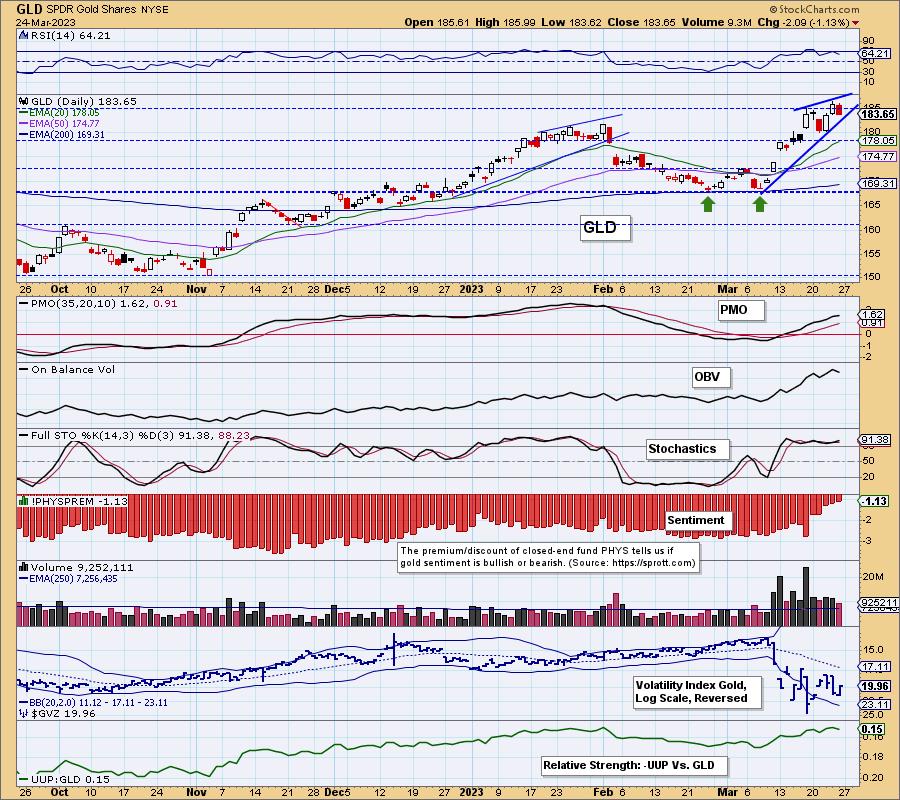
Consolidation above the February high is likely. Indicators remain positive enough and clearly investors are getting more bullish on Gold given the contraction in discounts on PHYS. Gold is still exhibiting strength against the Dollar so even if the Dollar continues to rally, Gold could still rally. It's the inverse correlation that could get in the way if the Dollar rallies further. The correlation is still quite strong so there will be downside pressure on Gold if the Dollar does do more than consolidate.
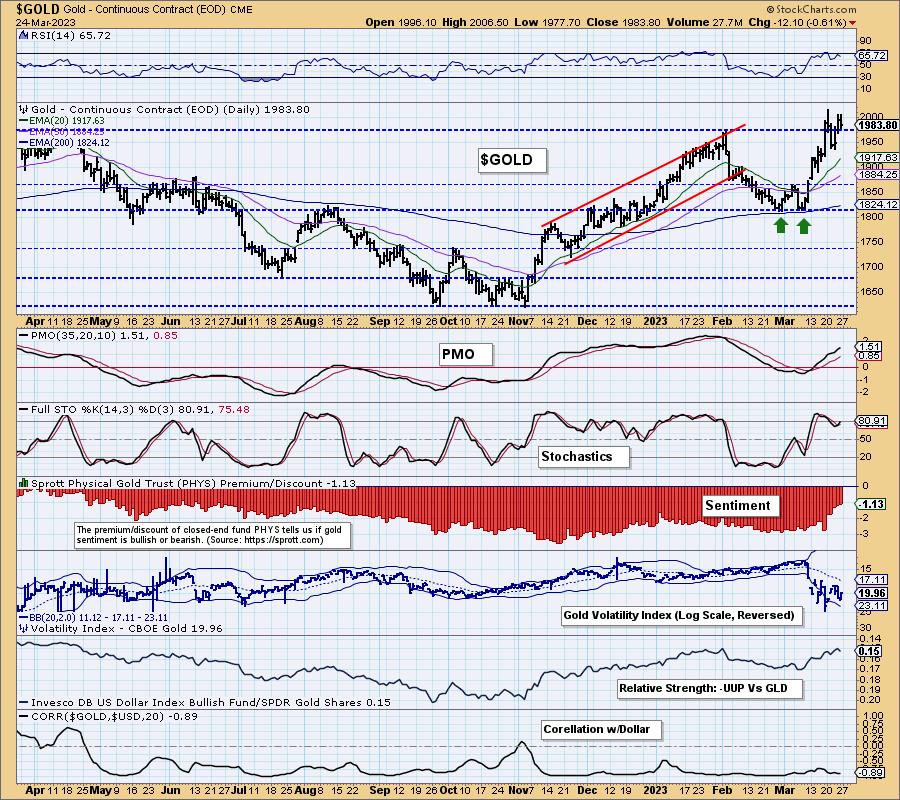
GOLD Weekly Chart: The breakout this week is very encouraging but all-time highs are a psychological barrier not just a price barrier. The weekly indicators do suggest a breakout. The weekly RSI is strong and not overbought. The weekly PMO is still rising strongly after bottoming above the signal line.
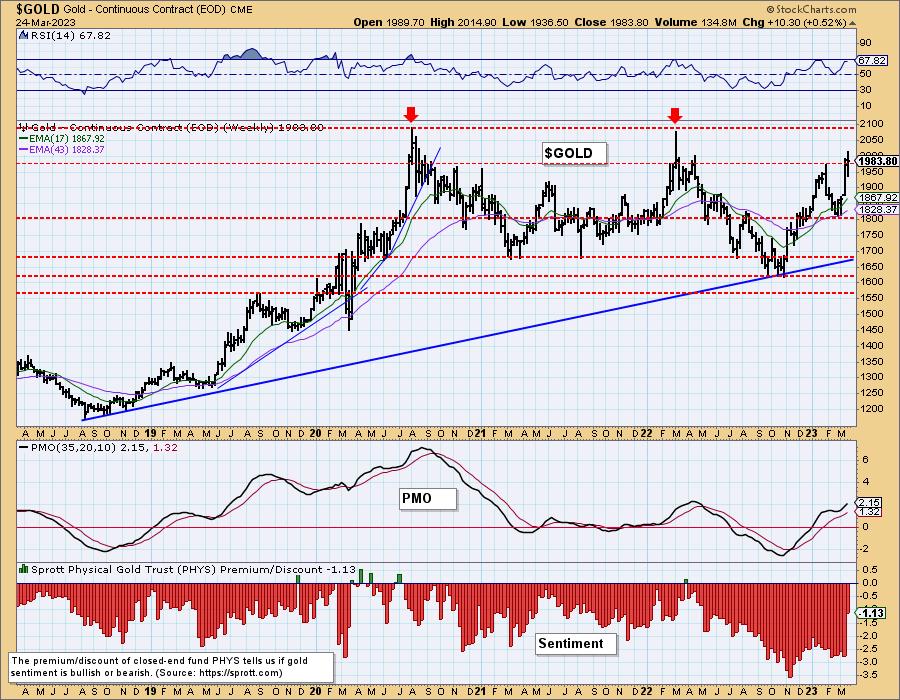
GOLD MINERS Golden and Silver Cross Indexes: Participation is outstanding on Gold Miners and is holding strong. The SCI is rising strongly and isn't overbought yet. The GCI just saw a positive crossover its signal line. The RSI is positive and not overbought. The PMO is rising above the zero line and isn't overbought. Stochastics are rising above 80. This group should continue through overhead resistance.
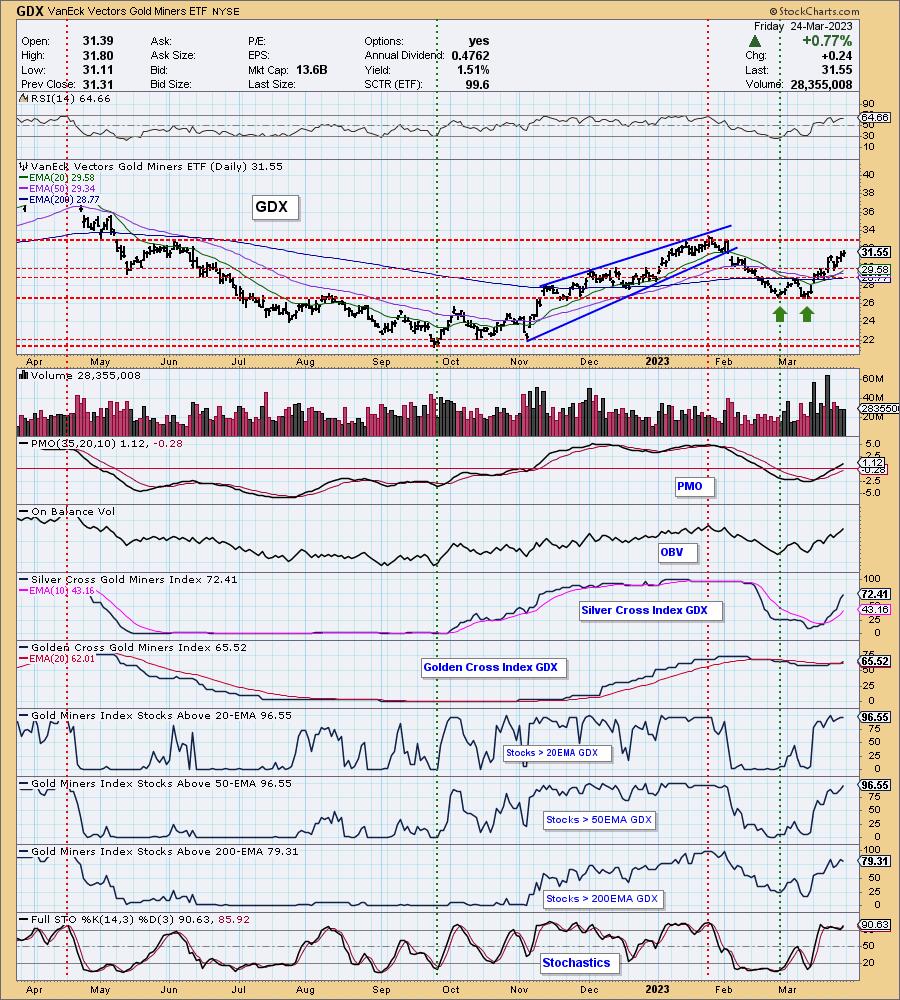
CRUDE OIL (USO)
IT Trend Model: SELL as of 2/2/2023
LT Trend Model: SELL as of 12/6/2022
USO Daily Chart: Crude Oil rallied most of the week, but ended up taking back half the gains to finish the week. On the bright side it formed a bullish hollow red candlestick. This means that price closed above the open, but happened to finish lower than the prior day. The indicators are not on USO's side. The RSI is negative and the PMO is moving lower. Stochastics have topped in deeply negative territory. A trip to support at $58 seems likely.
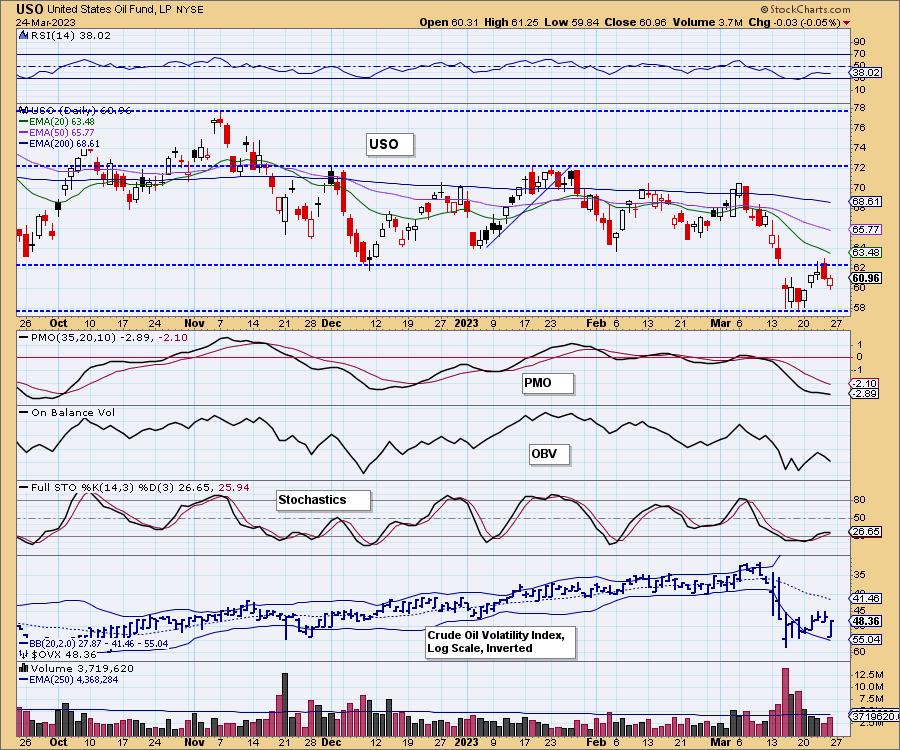
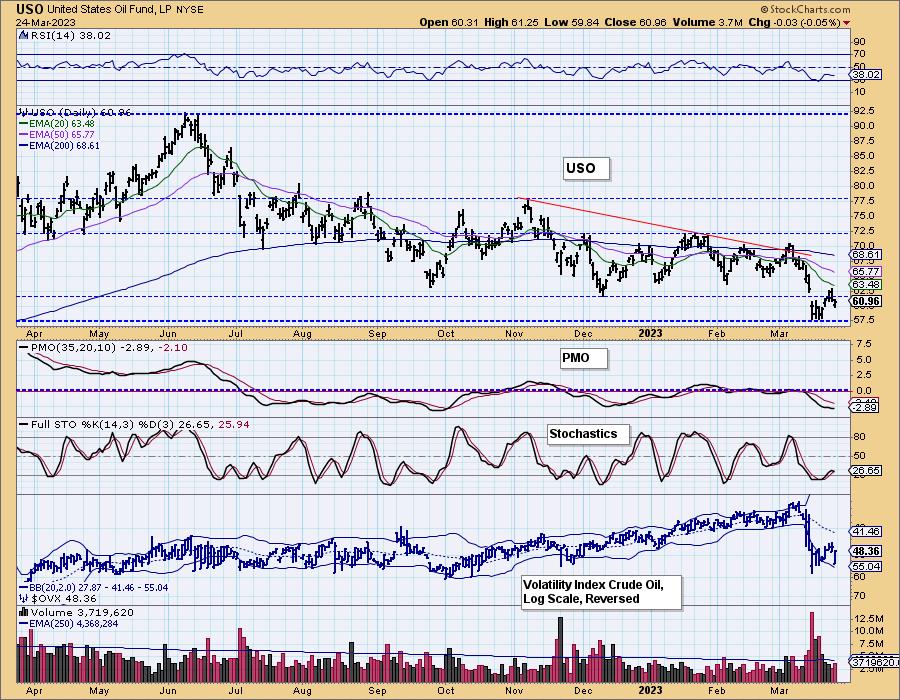
USO/$WTIC Weekly Chart: Bigger picture we are pleased to see very strong long-term support holding. This is a great place for a reversal, but we'd sure like to see at least one positive indicator. The weekly RSI is negative and the weekly PMO is accelerating after hitting negative territory. At best, USO will hold support but move sideways. This support is strong, but those indicators are troubling.
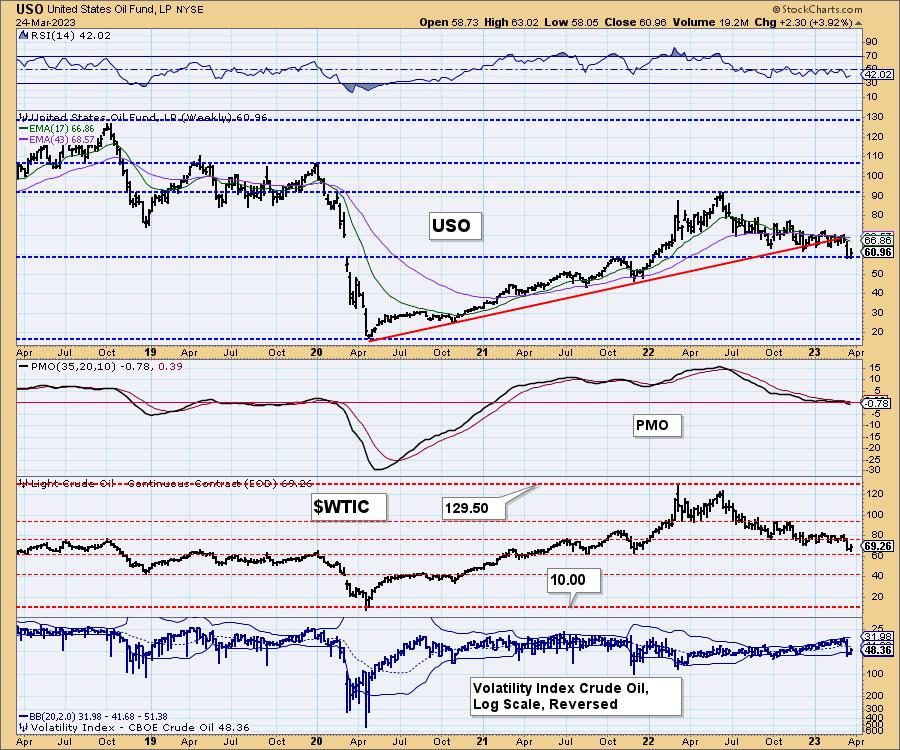
BONDS (TLT)
IT Trend Model: SELL as of 2/21/2023
LT Trend Model: SELL as of 1/19/2022
TLT Daily Chart: TLT benefited from the decline in yields, but its movement can best be described as tortured. It has been whipsawing around between 104 and 108. The symmetrical triangle that was formed is resolving as expected to the upside. These triangles are continuation patterns so refer to the prior trend to determine which way the breakout will occur. Indicators are positive, so we would look for at least a test of the top of the current trading channel between 99 and 108. We are leaning toward a breakout there given the RSI is positive, PMO is rising on a BUY signal in positive territory and Stochastics are rising in positive territory.
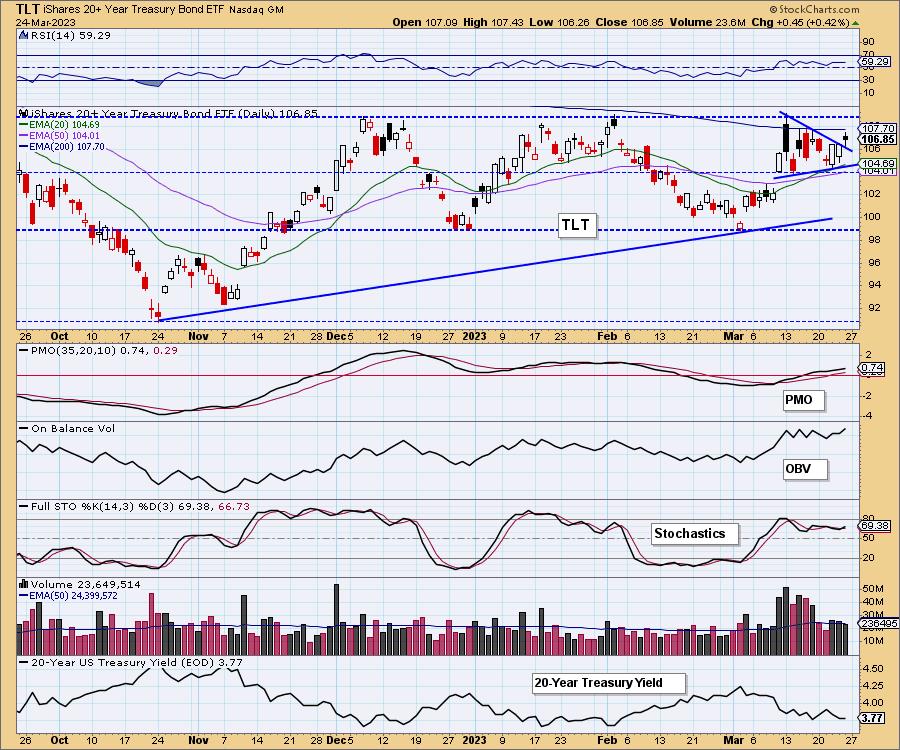
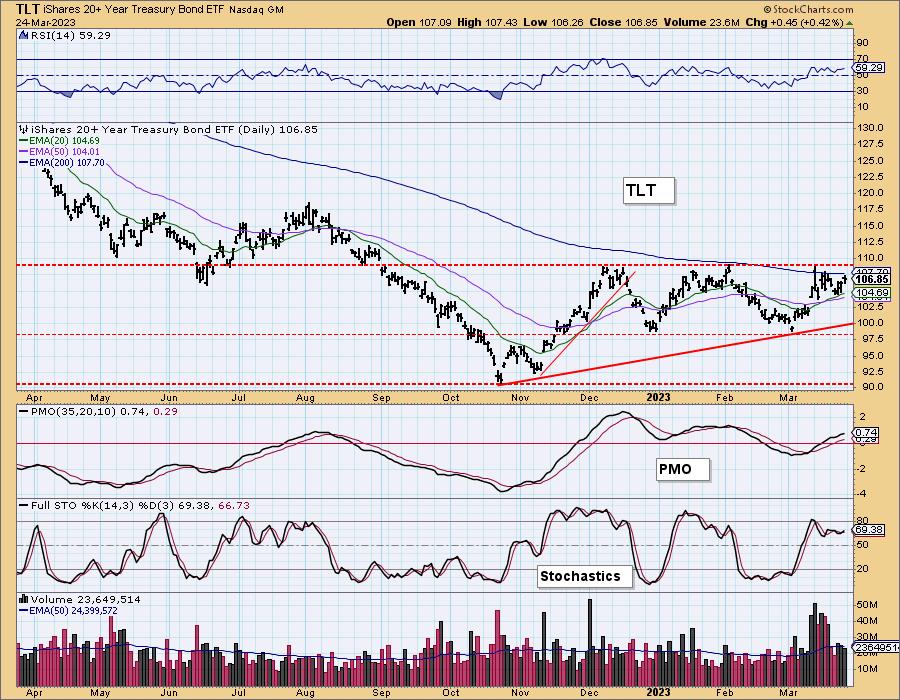
TLT Weekly Chart: The biggest concern right now would be the formation of a triple top. This is part of the reason we want that breakout now and not later. The weekly RSI is in positive territory and the weekly PMO is rising strongly so we would expect a breakout here.

Good Luck & Good Trading!
Erin Swenlin And Carl Swenlin
Technical Analysis is a windsock, not a crystal ball. --Carl Swenlin
(c) Copyright 2023 DecisionPoint.com
Disclaimer: This blog is for educational purposes only and should not be construed as financial advice. The ideas and strategies should never be used without first assessing your own personal and financial situation, or without consulting a financial professional. Any opinions expressed herein are solely those of the author, and do not in any way represent the views or opinions of any other person or entity.
NOTE: The signal status reported herein is based upon mechanical trading model signals, specifically, the DecisionPoint Trend Model. They define the implied bias of the price index based upon moving average relationships, but they do not necessarily call for a specific action. They are information flags that should prompt chart review. Further, they do not call for continuous buying or selling during the life of the signal. For example, a BUY signal will probably (but not necessarily) return the best results if action is taken soon after the signal is generated. Additional opportunities for buying may be found as price zigzags higher, but the trader must look for optimum entry points. Conversely, exit points to preserve gains (or minimize losses) may be evident before the model mechanically closes the signal.
Helpful DecisionPoint Links:
DecisionPoint Alert Chart List
DecisionPoint Golden Cross/Silver Cross Index Chart List
DecisionPoint Sector Chart List
Price Momentum Oscillator (PMO)
Swenlin Trading Oscillators (STO-B and STO-V)
DecisionPoint is not a registered investment advisor. Investment and trading decisions are solely your responsibility. DecisionPoint newsletters, blogs or website materials should NOT be interpreted as a recommendation or solicitation to buy or sell any security or to take any specific action.
